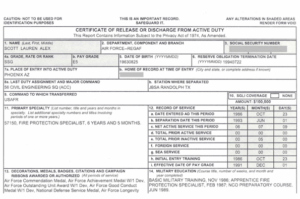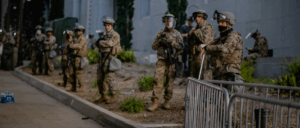The DD214 as a Foundational Document for Your Benefits Pursuit
When you leave the military, a new chapter begins. Before you can fully step into civilian life, there is one crucial document you need: your DD Form 214.
The DD214 is more than just a certificate of service; it includes specific data points that provide important context regarding your military career. While the DD214 serves as proof of service, elements such as your Character of Service and separation codes are essential for pursuing various benefits. A complete and accurate DD214 is a crucial first step before you can demonstrate a service-related connection through medical evidence.
What is a DD214 and Why is it So Important?
The DD214 is a form given to a service member when they leave active duty from any branch of the U.S. armed forces. Think of it as your official military summary.
You will need a copy of this form to prove your service and qualify for many benefits, including:
- VA Home Loans & Mortgages: You need proof of service to apply for these loans.
- GI Bill Education Benefits: The DD214 helps you get your education benefits.
- VA Benefits: It is a foundational document for any VA benefits evaluation. While the VA can try to find your records on their own, having your DD214 can help speed up the process.
- Civilian Jobs: Many government jobs and private companies ask for it to verify your military background.
- Veteran Discounts: Many businesses offer discounts to veterans who can show proof of service.
- Burial in a National Cemetery: A DD214 is needed for military funeral honors for you or a surviving family member.
Without your DD214, getting these benefits can be a frustrating and slow process. That’s why it’s so important to get and securely store this document.

What Information is on a DD214?
Your DD214 has a detailed summary of your military career. It has many sections, or “blocks,” that include a lot of information about your service.
Key information you will find includes:
- Your full name and Social Security Number.
- The dates you started and ended active duty.
- Your last job and rank.
- Military training and education you received.
- The awards, medals, and badges you earned.
- Your total time in service.
- The type of separation (like retirement or discharge).
- Your character of service (like Honorable or Other Than Honorable).
- Your Separation and Reenlistment codes.
Pro-Tip: The “Member 4”copy of your DD214 is the most important one to have because it includes your separation and character of service codes. Always request this version when dealing with benefits. This information may be reviewed by VA decision-makers as part of your overall record.

How to Get a DD214: A Step-by-Step Guide
The National Personnel Records Center (NPRC) in St. Louis, Missouri, is the official place that stores military service records. While you can start the process on the VA’s website, the NPRC is the one that sends your records.
Here are the most common ways to request your DD214.
Method 1: Online Request via the National Archives
This is often the fastest and easiest way to get your records.
- Go to the official website for the National Archives.
- Start your request by selecting “Start Request Online” to use the eVetRecs system.
- Enter your personal details and service information. Be as accurate as possible to avoid delays.
- You will need to confirm your identity through a secure service like ID.me. This keeps your private information safe.
- After you complete the form, submit your request. You will get an email confirming that it was sent.
You can check the status of your request at any time by logging back into the system.
Method 2: Request by Mail or Fax (Standard Form SF 180)
If you prefer a more traditional method, you can use the Standard Form SF 180.
- Download the form from the National Archives website.
- Fill it out completely with all the requested information, including your name, Social Security Number, and dates of service.
- Mail or fax the form to the address or number on the last page.
Note: Requests made by mail can take much longer to process (several weeks or even months) compared to online requests.
Getting Your DD214 as a Family Member
If you are the next of kin of a deceased veteran (like a surviving spouse, parent, or child), you can request a copy of their DD214. You will need to provide proof of the veteran’s death, such as a death certificate.
What if My Records Were Lost in the 1973 Fire?
The 1973 fire at the NPRC destroyed millions of military records. But don’t worry, the NPRC has other records they can use to create a new DD214 for you. The process may just take a bit longer.

What to Do While You Wait: A Checklist
Because records requests can take a significant amount of time, here is an actionable checklist of compliant steps you may take while the NPRC processes your DD214 request:
- 1. Gather Treatment Provider List: Compile a comprehensive list of all healthcare providers and facilities you have seen since discharge.
- 2. Organize Existing Service Medical Records: Locate and organize any service-related medical documents you already possess.
- 3. Research Benefits: Research the requirements for the benefits pursuit you are considering.
How to Correct or Update Your DD214
Even small mistakes on your DD214 can cause problems when you try to get benefits. If you think there is an error, you can ask for a correction.
- For Minor Errors: To correct small mistakes (like a misspelled name or a missing award), you can use a DD Form 215. This is an official addendum that should always be kept with your original DD214.
- For Major Errors: To correct a bigger mistake, or to try and upgrade your discharge, you must apply to the appropriate Service’s Board for Correction of Military Records. This process can be complicated and may require a lot of supporting documents.
How to Protect Your DD214 from Identity Theft
Your DD214 has sensitive personal information, like your full name and Social Security Number. This makes it a prime target for identity thieves.
- Store it Securely: Keep your physical DD214 in a fireproof safe, a secure file cabinet, or a safe deposit box. Treat it like your birth certificate or passport.
- Make Digital Copies: Create a password-protected digital copy and store it on an encrypted drive or secure cloud service. This gives you a backup in case the physical copy is lost or damaged.
- Be Careful Online: Never upload or share a copy of your DD214 that has not been edited to remove sensitive information. If a service provider needs it, ask if you can send a redacted version.
Trajector Medical’s Role: Medical Evidence Experts
Obtaining your DD214 is the critical first step in your benefits journey. Once you have documented your service, the next phase involves compiling clear, comprehensive medical evidence to support your pursuit.
Trajector Medical specializes in medical evidence consulting. We do not handle claims, file paperwork, provide legal representation, or give directives on the VA process. Our focus is on providing veterans like you with robust medical documentation.
We may be able to assist you with:
- Documentation Review: Helping you understand the potential strength and gaps in your existing medical records relative to your service history as documented on your DD214.
- Medical Evidence Strategy: Consulting on the type of evidence that could potentially best support the impact and severity of a documented condition you are seeking to document for your evaluation.
Our service is strictly evidence-based. You, the client, always maintain control over how you choose to use the medical evidence we help you prepare. We aim to honor your service by enabling you to effectively document your health challenges for your benefit evaluation.











